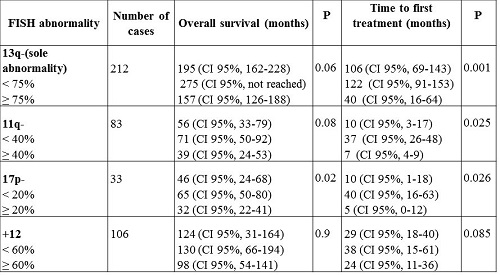Abstract: PB1761
Type: Publication Only
Background
Genomic aberrations detected by FISH have become one of the most important and widely used prognostic factor for chronic lymphocytic leukemia (CLL) patients. In addition several publications have described that patients with a higher percentage of abnormal nuclei have a worse outcome.
Aims
To analyze the effect of the percentage of abnormal nuclei detected by FISH (13q deletion (13q-), 11q deletion (11q-), 17p deletion (17p-) and trisomy 12 (+12)) in overall survival (OS) and time to first treatment (TTFT).
Methods
We studied a non-selected cohort of 650 consecutive CLL cases from a local database with a median follow up time of 50 months (0-346). The cut-off point for the percentage of abnormal nuclei for each alteration was detected by dividing the variable into deciles, and selecting the most efficient cut-point, and based on previous publications.
Results
FISH detected aberrations in 68% of the cases (442/650). The most frequent abnormality was 13q-, observed in 302 patients (47%), but as a sole alteration in 212 cases, followed by +12 (106 patients, 16%), 11q- (83 patients, 13%), and 17p- (33 patients, 5%). As expected, the group of patients with 13q- as a sole abnormality was the one with the better OS (195 months) followed by the group of patients with normal FISH (160 months), +12 (124 months), 11q- (56 months) and 17p- (46 months), consistent with the Dohner hierarchical classification (Döhner H et al. NEJM 2000). Similar results were observed in TTFT: 13q- as sole abnormality (106 months), normal FISH (112 months), +12 (29 months), 11q- (10 months), 17p- (10 months). The best predictive cut-off point that divided patients according to its prognosis was different for each alteration. We confirmed that a high percentage of cells carrying the deletion is associated with a significantly worse TTFT in cases with 17p, 13q, and 11q deletions, and a significantly shorter OS in cases with 17p deletion. We observed a similar trend for OS in cases with 13q and 11q deletions, probably not significant because of the low number of patients included, compared to previous studies. We observed the same trend in patients with +12. The table summarizes these findings. Probably with a higher number of cases and a longer follow up, it could have also been possible to reach statistically significant differences in the subgroups in which it was not objected.

Conclusion
Not only the type of cytogenetic abnormality but also the percentage of abnormal nuclei detected by FISH are important factors in the prognosis of CLL patients.
Session topic: 5. Chronic lymphocytic leukemia and related disorders - Biology
Keyword(s): Prognostic factor, FISH, Chronic Lymphocytic Leukemia





